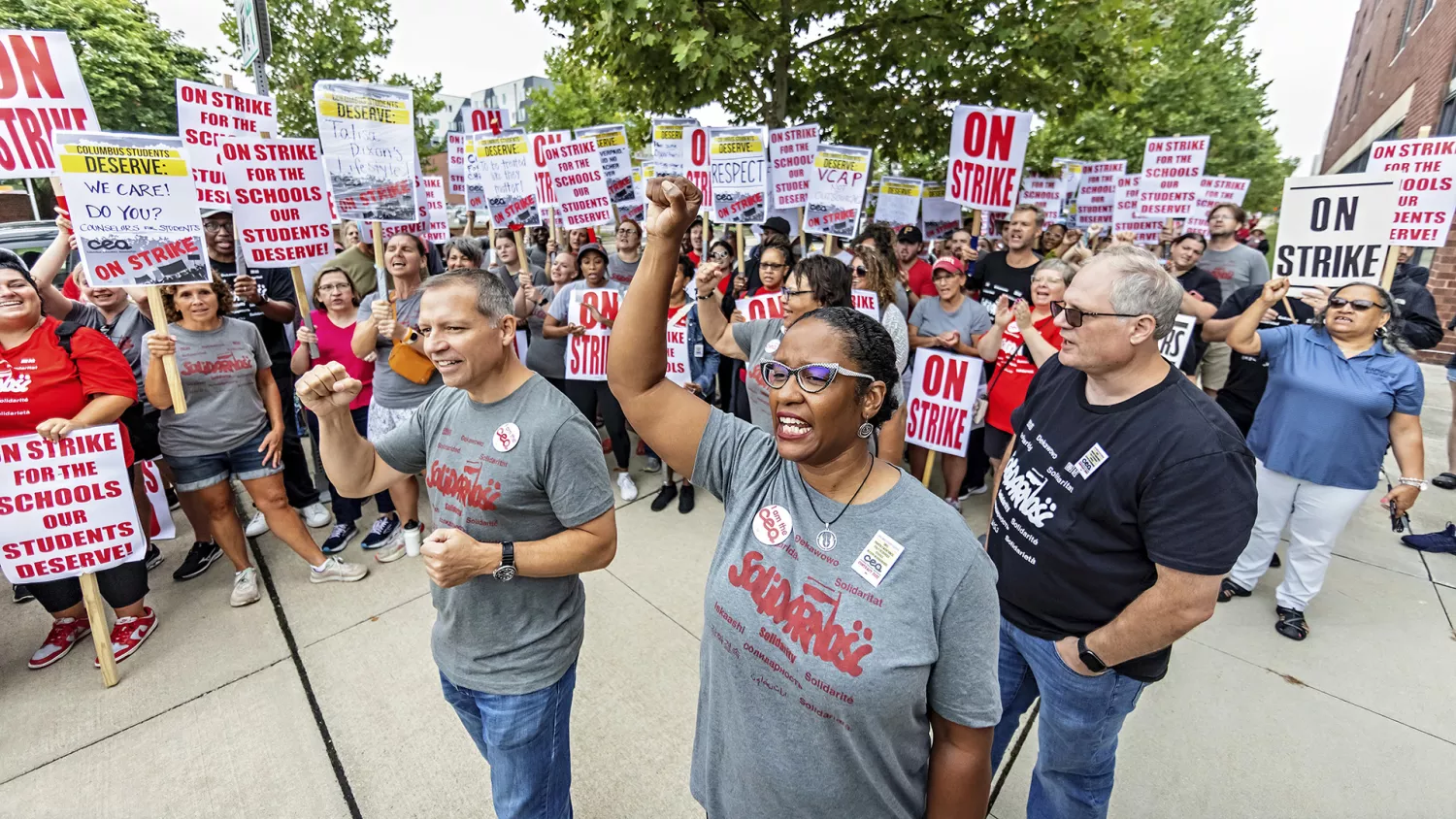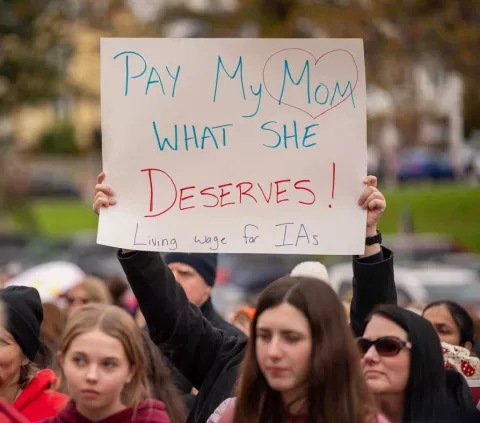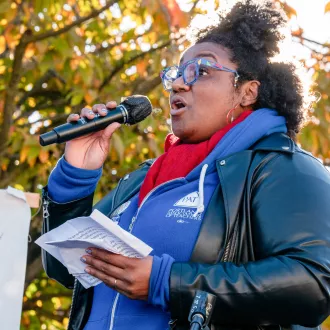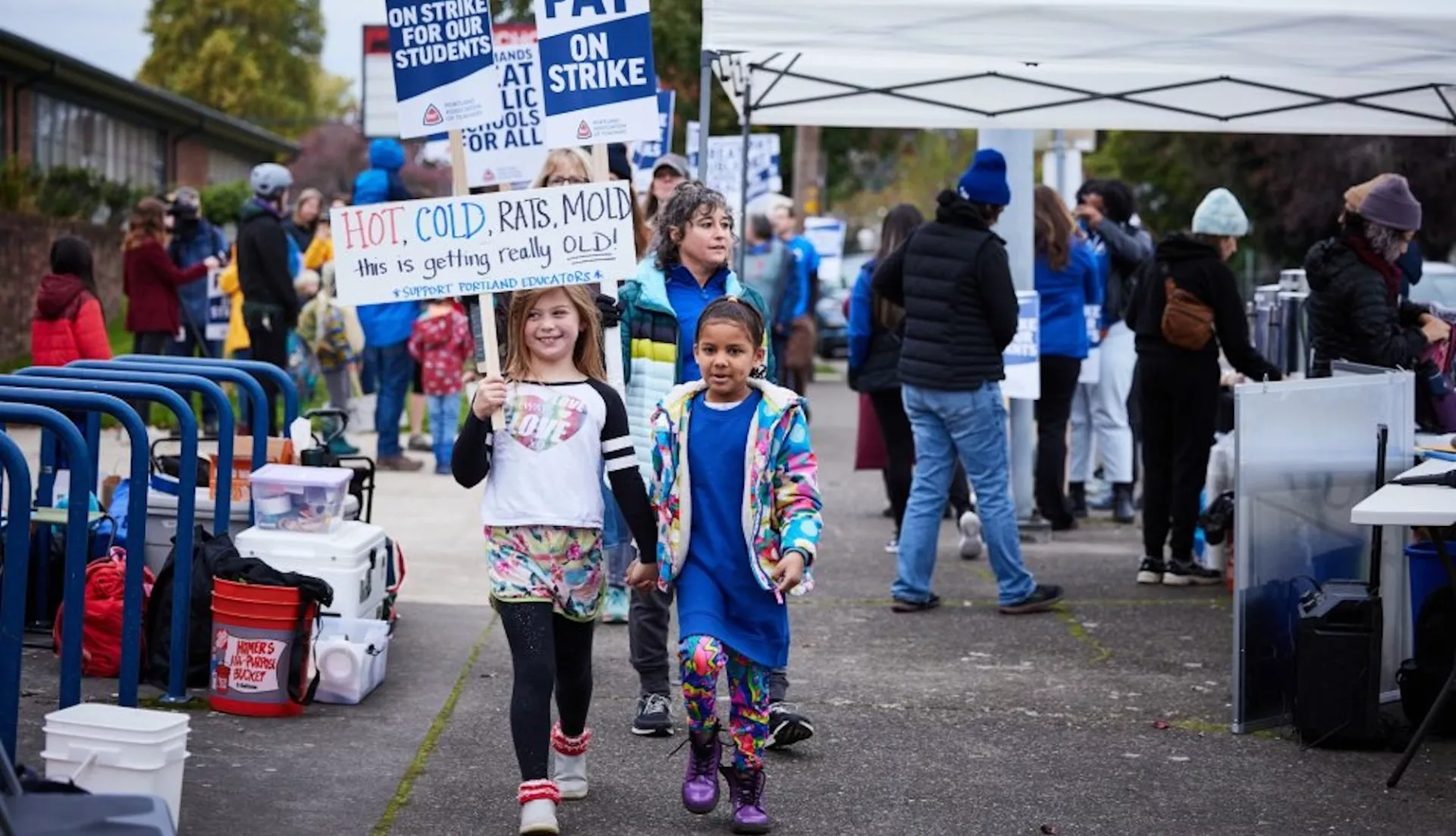Key Takeaways
- Strikes cause teacher pay to rise by 8 percent, or roughly $10,000 per teacher, by the fifth year after a strike.
- Strikes also improve working conditions, such as class sizes, per-student funding, and investments in nurses, school social workers, psychologists, and others.
- There is no “sizable positive or negative effect on student achievement,” but students do learn how to stand up for themselves, teachers say.
A first-of-its-kind study has found that teachers’ strikes lead to increased teachers’ pay. And, not only that, strikes also cause additional per-pupil spending, lower class sizes, and more investment in non-teaching employees, like nurses and social worker.
Or, as Vox puts it, “U.S. teacher strikes were good, actually.”
Figuring this out was an enormous task for researchers, who took nearly four years to comb through about 90,000 news articles—"which does sound insane when you say it,” acknowledges lead author Melissa Arnold Lyon—and assemble a novel database of 772 teacher strikes in 27 states between 2007-2008 and 2022-2023. Last month, the research team published their analysis of this data in a paper produced by the National Bureau of Economic Research, entitled, “The Causes and Consequences of U.S. Teacher Strikes.”
Their chief findings include:
* Strikes increased compensation by 8 percent, or roughly $10,000 per teacher per year, by the fifth year after a strike.
* Strikes also improved working conditions, with student-teacher ratios decreasing by 0.5, on average, or 3.2 percent. They also caused an approximate 7 percent increase in spending on non-instructional staff, like social workers, nurses, etc.
* These improvements to salaries and working conditions came from new money to districts from states, rather than the reallocation of existing district funds.
* There are “no sizable positive or negative effects on student achievement,” the study’s authors note.
Today, teacher strikes are illegal in 37 states, but the study’s authors point out that a strong majority of the U.S. public supports the rights of teachers to strike, and it's common to see parents, students, and community members on educators' picket lines. (Specifically, 78 percent of parents and 73 percent of the overall public said they would support teachers if they go on strike in their community, according to a PDK poll.) Labor protest is a form of speech—recently, the chief negotiator of the St. Paul Federation of Educators called it “the cry of the unheard.” For these reasons, NEA and its affiliates are working to make sure all educators can exercise this right.

The Key Issues in Teachers Strikes
Using the new dataset, the research team first examined the key issues in every one of their 772 strikes.
Did teachers strike over wages? Or were they fed up with working conditions, like too-big class sizes or a lack of social workers, nurses, and other non-teaching staff? Or were they making a stand about “common good” issues, like affordable housing, racial justice, climate change, or something else?
In nine out of 10 strikes (89 percent), teacher pay was a key issue, researchers found. They also found that striking worked. “It is a fact that teacher strikes are increasing teacher salaries,” says Lyon, a NEA Higher Ed member and assistant professor of public policy at the University of Albany.
“Specifically, we find that strikes cause average compensation to increase by 3% ($2,000 per teacher) in the year after a strike. Compensation then continues to increase in the following years, reaching an increase of roughly 8% ($10,000 per teacher) in the fifth year after a strike,” the study’s authors wrote.
In Oakland, Calif., for example, a 7-day strike in 2023 led to a salary schedule that boosts pay for first-year teachers by nearly $10,000 to $63,000. In Seattle, a 6-day strike in 2022 won teachers 14 percent raises over three years.
Importantly, the researchers found that the new pay raises, caused by striking, did not come from the reallocation of district funds. Instead, these districts got additional money from states, as the strike made clear to voters and lawmakers that more money was needed.
“These strikes aren’t just a conversation with districts. It’s a conversation with the public,” Lyon notes. Parents and community members can see that teachers have been pushed the brink, as can lawmakers. “It’s a signaling event,” says Lyon, “which leads to a broader conversation with the public” about the need for educational change.
Other pay-related findings include:
- When teachers strike, non-instructional staff in those districts also end up with pay raises, an average of 7 to 10 percent. “This may reflect the nature of collective action,” the study notes.
- In addition to pay, strikes also cause teacher benefits (such as healthcare) to increase by 6 to 9 percent, or $2,700 to $3,400, over the five years following a strike.
- The money to pay for increased wages comes from new money into districts, almost always from the state. It does not come from increased class sizes or workforce reductions, researchers found.
Quote byMelissa Lyon , Assistant Professor of Public Policy, SUNY Albany

It’s Not Just About Pay
While pay is important, it isn’t the only driver in teacher strikes, researchers found. Indeed, researchers found that the baseline pay of striking teachers (before they strike) is about the same as the baseline pay of non-striking teachers.
What was different? Funding and support. The striking districts generally had lower per-student funding and worse teacher-student ratios. They also were more likely to serve higher proportions of students of color, students living in poverty, and students learning English.
This finding doesn’t really surprise Angela Bonilla, president of Oregon’s Portland Association of Teachers, where teachers held a 15-day strike last fall. “Those are districts that tend to get our newest educators, the ones who need the most,” she notes.
Those districts, like Portland, also have plenty of committed educators who choose to stick around. Think about what that means, says Bonilla.
“They are choosing intentionally to serve students who are systemically underserved. They are choosing to make a difference,” says Bonilla. “It makes sense that these educators who choose to do something radically different—who choose these students—are the same people saying we can and have to use our power as unionized educators to make something different happen!”
While pay featured in 89 percent of strikes, working conditions featured in two-thirds. And, just like with pay, strikes worked. Consider these two findings:
- Class sizes decreased. The researchers found that, on average, “teacher strikes lead to a decline in pupil-teacher ratios of about half a student in three to five years after a strike. This suggests that districts slightly decrease class sizes in response to teacher strikes,” the study’s authors write.
- Funding increased. In general, teacher strikes also increase “working-condition expenditures” by 5 to 7 percent in those 3-5 years. Working-condition expenditures include the salaries of non-teachers—people like school nurses, behavioral specialists, social workers, psychologists, and others.
Historic strikes in Los Angeles, St. Paul, Minn., Seattle and many other places illustrate these findings. In 2019, in Los Angeles, striking educators won more librarians and school nurses, as well as lower class sizes. In 2020, St. Paul union members won important investments in students’ mental health. In Kent, Wash., the strike led to smaller classes, additional paraeducators, and better caseloads for special educators.
"We did not go on strike over money," says Kent Education Association president Tim Martin. He and his colleagues were motivated to stop the district's union-busting activities and to get more mental-health supports for students and more support for special education teachers. "I think we did get a raise, but it wasn't substantial because it wasn't our focus."
Two years ago, in Ohio, the Columbus Education Association’s strike targeted class sizes, a lack of support for art educators, and health and safety concerns. In the district’s many classrooms without air-conditioning, students and educators literally dripped sweat on desks. One year later, when Columbus teacher Joe Decker finally had a temperature-controlled classroom, “I got a little teary-eyed, to be honest!” he recalled.
Striking for the Common Good
The third area of concern for striking teachers were “common good” issues. About 1 in 10 teacher strikes featured issues like that, with more in recent years. “The emphasis on teacher salaries is declining,” notes Lyon. “It’s still a lot, but the trend seems to be increasing for common-good issues.”
In Oakland, for example, striking teachers won agreements providing for student transportation and housing.
Educators care about these things because they care about students and families, and they know it’s important for students to be able to sleep in the same bed every night, to be safe from eviction and homelessness.
“In the end, we’re doing this because we care about our communities. We care about our students and families. And we care about each other," says Bonilla.
The Question of Student Achievement
The new dataset is one of a kind. Historically, the federal government used to track all strikes, but during the Reagan era it stopped tracking strikes involving fewer than 1,000 people, which describes the vast majority of teacher strikes. The dataset’s existence today will state the record on teacher strikes and their effects, notes Lyon.
It's clear now that they help teachers. It's equally clear they do not harm students. Researchers dove into student achievement data in striking districts and found that the vast majority of strikes don’t seem to have any effect on achievement. Strikes that last two weeks or more have a short-term effect on math achievement, causing test scores to drop by 0.3-0.5 percent in the year of the strike. A year after the strike, they're back to normal.
In the long run, strikes may help students, Lyon said. “We’re limited (in data), but we can’t rule out long-term effects,” she said.
In general, other studies show that districts must increase funding by at least $1,000 per student to see improvements in student test scores, Lyon notes. A few strikes elicited that degree of investment after a few years, but then it takes even more years for results to be seen. Complicating matters, since 2020 it’s become nearly impossible to untangle student achievement data from the effects of the pandemic.

To many teachers, it makes sense that raising teacher pay has a positive effect on students. If their teachers aren’t working 2-3 jobs, if they’re able to afford to live in the same communities where they teach, if they aren’t selling their own blood plasma, it’s got to be a good thing for students. Having more social workers, school psychologists, classroom aides, and other educators also is a good thing.
Some effects may be immeasurable, teachers say. “I’ve had students say to me, ‘that’s not fair, maestra,’” says Bonilla. “They see what we experience, and they learn, explicitly and implicitly, from what we teach them and what we don’t. What they learn from a strike is that there is a point where you have to stand up for yourself. And that doesn’t mean you punish somebody in a hallway, but you keep talking, you keep saying, ‘this is what we deserve.’
“It’s important for them to see that change is possible. And sometimes that change is disruptive. The point of a strike is to disrupt,” she says. “But we’re going to have a better school system because of it.”
Other Findings
Other findings include:
- The median number of teacher strikes per year was 12.5, resulting in a yearly national average of 89 days of canceled school.
- Most teacher strikes are brief; the most common length is just 1 day.
- Most teacher strikes take place on the west coast, mid-Atlantic and Midwest.
- Strikes took place in 610 districts in 27 states between 2007 and 2023, with the most in Pennsylvania (59), Illinois (43), California (38), and Washington (30). Nine states experienced coordinated strikes, like the well-known Red For Ed strikes in West Virginia, Arizona, Oklahoma, and elsewhere.
Quote byAngela Bonilla , President, Portland Association of Teachers




